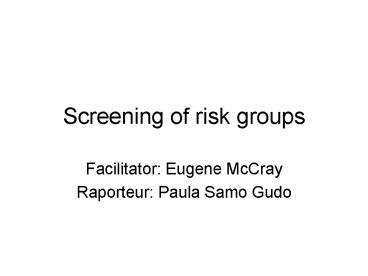Screening of risk groups - PowerPoint PPT Presentation
1 / 6
Title:
Screening of risk groups
Description:
Screening of risk groups ... alcoholics, etc) Miners Vulnerable groups with poor access (indigenous, slums, migrants, refugees, homeless, etc) ... – PowerPoint PPT presentation
Number of Views:83
Avg rating:3.0/5.0
Title: Screening of risk groups
1
Screening of risk groups
- Facilitator Eugene McCray
- Raporteur Paula Samo Gudo
2
Current situation in countries
(China, Russia, Ethiopia, India, Mozambique,
Russia, Zimbabwe, EMR)
- Key high risk groups identified
- Prisoners
- Contacts
- PLWHA
- Other clinical risk groups (diabetics, COPD,
undernourished, alcoholics, etc) - Miners
- Vulnerable groups with poor access (indigenous,
slums, migrants, refugees, homeless, etc) - Health care workers
- Current actions in countries
- Screening for TB in people with HIV is done to
some extent in all countries, but much further
scale up needed - Contact investigation often part of policy, but
implementation still very low - Actions in prisons fairly common, but not
consistent and standardised - Several examples of screening of other risk
groups, but patchy, with great variability, and
without guidelines
3
Key risk groups discussed
- Prisoners
- High risk, and vulnerable, and poor access
(migrants, refugees, slum-dwellers, homeless,
etc) - Clinical risk groups (beyond HIV smokers,
diabetics, malnourished, alcoholics / substance
abuse, etc) - Health care workers
4
Main challenges Action by DEWG Action by NTP
1. Screening prisoners Most cost-effective and feasible screening algorithm not established Issues around coordination, on ministry and service delivery levels Collect best practice for implementation Develop screening algorithm Advocacy Screening is part of IC in prisons (need to develop better IC guidelines for prisons) Document and share current practices Use PPM tools for develop collaboration Advocacy on ministry and service delivery levels Involve prisoners (Ex-TB) as part of ASCM strategy
2. Vulnerable populations Lack of data on who, where, and size of problem Mobility of migrants, including cross-border Access, health systems Situation analysis, best practice collection centres of excellence Guidelines and tools development Coordinate with NGOs, IOM, UNHCR, ILO Advocacy Mapping risk populations Expanding free access to NTP services to migrants Consider outreach initiatives
5
Main challenges Action by DEWG Action by NTP
3. Clinical risk groups Cost-effective? Feasible in weak health systems? Most cost-effective and feasible screening algorithm not established How to identify risk groups? Stimulate research Collect best practices identify Centre of excellence Link with other disease programmes (TB/HIV equivalent) Mapping of risk groups, their health seeking, and the care they receive Document existing experiences of screening
4. Health care workers Basic data on priority risk groups? Lack of clear guidelines Stigma Unclear compensation for occupationally acquired TB Collect data to identify most at risk groups Develop guidelines Support in-country capacity building Communication campaigns Implement existing policy (when in place) Stimulate opportunities for sharing experiences within and across health care workplaces
6
Key steps
- NTP
- Situation analysis with mapping of risk groups
- Documenting existing initiatives
- Ensure implementation of existing policies
(especially HIV and contact investigation) - Link with other disease programmes, health and
social care providers, NGOs, etc - Improve coverage, access, quality for all risk
groups
- DEWG
- Link with other disease programmes (diabetes,
tobacco, substance abuse), other agencies (ILO,
IOM, UNHCR, WFP) - Research, evaluation, best practice (centres of
excellence) - Guidelines development
- Advocacy, and resource mobilization
- Capacity building and TA
Joint work across all above all risk groups, and
other risk groups (not 4 different guidelines)































